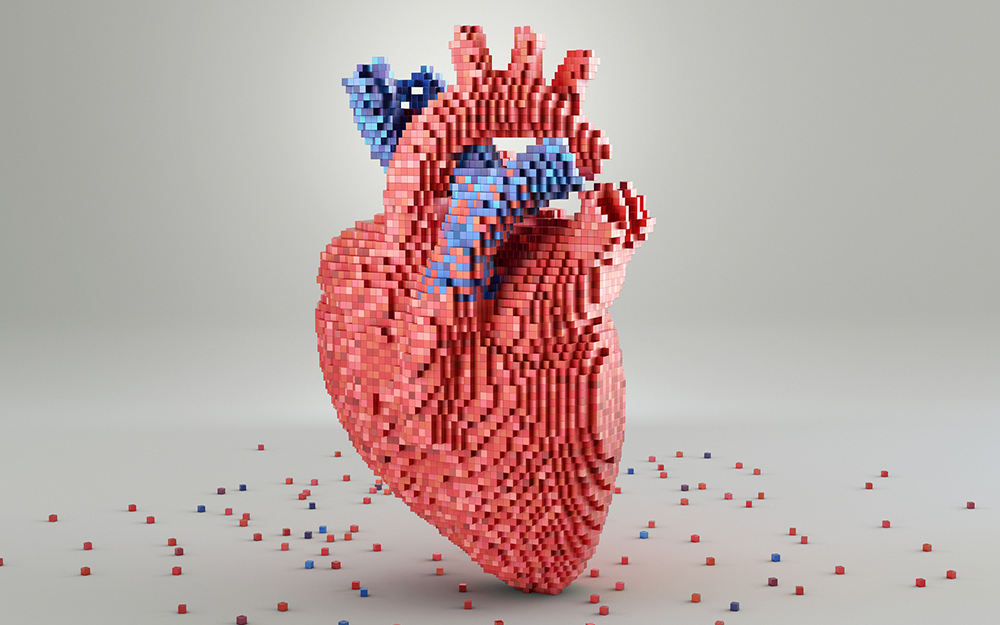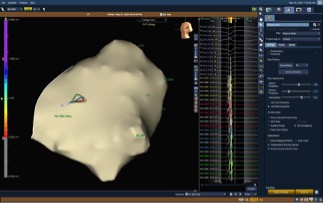Cedars-Sinai Blog
Cardiac Rhythm Disorders & Advanced Therapeutic Program for Ventricular Tachycardia
Nov 19, 2021 Cedars-Sinai Staff

Catheter ablation
Catheter ablation of the heart is a process whereby small tubes fitted with electrical wiring and special metal tips deliver radiofrequency (heating) or cryo (freezing) energy to areas of interest in the heart muscle in various chambers. These tubes, along with other tools such as ultrasound cameras, are inserted into the leg veins and arteries that lead to the heart without the use of open-heart surgery. Areas of interest that are targets for catheter ablation are muscle fibers that show abnormal electrical activity during the heart rhythm disorder (often stimulated during the procedure), or appear to have abnormal electrical activity during normal heart rhythms that could promote the formation of abnormal heartbeats.
"Catheter ablation of the heart is a process whereby small tubes fitted with electrical wiring and special metal tips deliver radiofrequency (heating) or cryo (freezing) energy to areas of interest in the heart muscle in various chambers."
Advanced therapeutic program for ventricular tachycardia
Ventricular tachycardia (VT) is an electrical abnormality originating from the pumping chambers of the heart muscle (ventricles). This heart rhythm disorder results in rapid heartbeats, often associated with palpitations, shortness of breath and other chest symptoms. In the setting of heart damage and scar tissue formation, due to prior heart attacks or non-heart-attack-related disorders, VT can potentially be lethal and often requires treatment with an implantable cardioverter-defibrillator (ICD) for lifesaving therapy. However, an ICD cannot prevent episodes of VT. Therefore, medications or catheter ablation is needed to control this heart rhythm disorder.
Catheter ablation of VT (CAVT) in the setting of scar tissue in the ventricles is the most complex procedure performed by the cardiac electrophysiology team (heart rhythm specialists). Most patients who are considered for this therapy have weakened hearts (cardiomyopathy) and congestive heart failure (CHF). They may also be older and have additional medical problems such as diabetes, chronic kidney disease or emphysema/COPD. Catheter ablation is considered after discussion and collaboration with a team of experts in cardiac anesthesiology, advanced heart failure and heart rhythm specialists. In some cases, the procedure risk is too high and medical therapy is considered. If deemed an acceptable risk, the procedure is performed with the care of the cardiac electrophysiology and anesthesiology teams. Occasionally, special pumps called temporary left ventricular assist devices (tLVADs) are required to support the person’s blood pressure and circulation during the procedure.
Combined endocardial and epicardial electrical mapping and ablation
The heart muscle is a three-dimensional structure consisting of an inner surface and outer surface—like a balloon. To perform electrical analysis (mapping) and catheter ablation on the inner surface of the heart (ENDOcardium), the heart rhythm specialist advances tools from the leg veins or arteries (femoral vein or artery), which lead directly into the heart chambers. If the area of interest is potentially on the surface of the heart, the heart rhythm specialist will perform a special procedure called pericardial puncture to access the space overlaying the outer surface of the heart (EPIcardium). The heart is encased in a sac in the chest called the pericardium. With a small needle advanced carefully underneath the rib cage, the pericardial sac can be accessed and tools can be inserted to analyze and perform catheter ablation on the outer surface of the heart. This procedure is called epicardial mapping and ablation and can be performed separately or combined with standard catheter ablation procedures for VT.
Open-chest hybrid surgical electrical mapping and catheter ablation

Video 1. Open-chest epicardial electrical mapping (OCEEM)—By touching the outer surface of the beating heart during open- heart surgery, an electrical mapping catheter is used to build a virtual heart with 3D software that shows areas of scar tissue (gray color) and healthy tissue (purple color), with other colors representing a mixture of scar and healthy in between. Scar tissue is targeted for catheter ablation.
A multidisciplinary team consisting of heart rhythm, advanced heart failure and cardiac surgery specialists may recommend treatment of both advanced cardiomyopathy/CHF and VT with an innovative procedure, combining the surgical implantation of a permanent LVAD (pLVAD) with electrical mapping and catheter ablation during the same procedure. This is our approach to patients with advanced cardiomyopathy/CHF that qualify for pLVAD implantation and have VT that is uncontrolled with conventional measures. A streamlined approach is taken in the operating suite where cardiac surgeons and heart rhythm specialists collaborate. Once the surgeon obtains access to the chest cavity, the beating heart is evaluated with open-chest epicardial electrical mapping (OCEEM), whereby the heart rhythm specialists evaluate the surface of the heart with specialized, high-resolution tools to identify areas of electrical abnormalities and scar tissue that could lead to VT. (See Video 1.) Once the areas of interest are identified by OCEEM, a special ablation catheter called a cryoablation probe (CAP) is used to freeze the area of the heart muscle and eliminate the electrical abnormalities.
In Discoveries: The Pulse of Surgical Progress
Surgical neuromodulation: Resection of the stellate ganglion
Ventricular tachycardia is a complex heart rhythm disorder not only due to heart muscle that has been weakened by scar tissue, but by nerve endings in the heart from the spinal cord that electrically excite the heart. The process whereby the nervous system is directly targeted to prevent VT is called neuromodulation. Some forms of medications not only affect the heart muscle but may have neuromodulation effects (i.e., beta blockers). In certain cases, VT cannot be controlled by medications or catheter ablation, and surgical neuromodulation may be required. This procedure is called cardiac sympathetic denervation (CSD) and is performed by a thoracic surgeon in consultation with the heart rhythm specialists. The excitable nerve that branches out from the spinal cord near the lower part of the neck and connects to the heart, specifically the stellate ganglion, is directly visualized during minimally invasive surgery of the chest wall (laparoscopic thoracotomy). Once this nerve is visualized, it is cut/severed by the surgeon with care not to injure other nerves in the area. This procedure is usually performed on both sides of the body targeting the stellate ganglion on the left and right sides.


